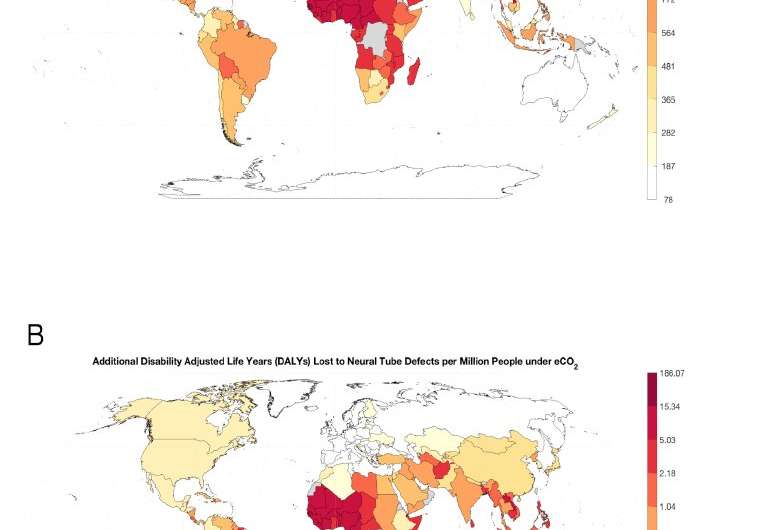Nutrient deficiencies in rice grown under higher carbon dioxide could elevate health risks for tens of millions

As a result of rising atmospheric carbon dioxide concentrations, Earth is experiencing many discernable changes, such as melting glaciers, higher global sea levels, and an overall greening of the planet. But increasing carbon dioxide concentrations are also causing many invisible effects, including detrimental changes to the nutritional content of food.
In the past decade both laboratory and free-air studies have shown that crops of many dietary staples, including wheat, barley, rice, potatoes, and soybeans, develop lower concentrations of iron, zinc, protein, and other nutrients crucial to human health when they are grown under elevated levels of carbon dioxide. However, the specific implications of these changes for global health have been difficult to estimate, in part because these calculations are based upon experimental data that can take years to generate.
Now a recent study in the AGU journal GeoHealth finds declines in B-vitamin concentrations in rice grown under elevated carbon dioxide concentrations may increase the future health risks of large numbers of people around the globe.
B vitamins, including thiamin (B-1), riboflavin (B-2), and folate (B-9), are important nutrients that support many bodily functions, including healthy cell metabolism and brain function. They also help prevent infections, and regulate hormone and cholesterol production. Many developing countries depend on rice as a primary source of many B vitamins.
As a result of the projected changes in B vitamins in rice, "tens of millions of people will be at risk of developing new B-vitamin deficiencies, with all the health implications that come with them," said Matthew Smith, a global health researcher at the Harvard T.H. Chan School of Public Health and lead author of the new study.
"It's pretty striking, given that we're only talking about one food," he said.
Global health implications
Smith and co-author Samuel Myers, from Harvard University's Center for the Environment, based their analysis on recently published nutritional analyses of rice grown at 550 parts per million carbon dioxide—a level that emissions forecasts indicate could be achieved as soon as 2050.

"A new experimental study looking at riboflavin, folate, and thiamin in rice showed there were big drops in all those B vitamins," said Smith. With those losses averaging 17 to 30 percent—much higher than what has been observed for other nutrients in rice—the researchers wondered what the health implications would be for what Smith described as "the single-most important food calorically in the world."
Using a statistical model based on average B-vitamin nutritional requirements, the team identified where future dietary deficiencies could occur from carbon dioxide-induced B-vitamin losses in rice. The results suggested that even moderate declines in B vitamins could have substantial global health impacts.
The team's findings indicated that tens of millions of people would have a new risk of deficiencies, including 132 million for folate deficiency alone. Inadequate intake of this nutrient by pregnant women has consistently been linked to higher likelihoods of neural tube birth defects in their offspring.
The researchers estimated that the predicted changes to the nutritional density of rice would result in an overall 0.5 percent increase in deaths and life-years lost from new neural tube birth defects—a burden that would fall most heavily on populations in Southeast Asia and western, central, and eastern Africa.
The results indicate "a major vulnerability" to anthropogenic carbon dioxide emissions in our food system, according to Smith.
"This is especially true for developing countries whose citizens are already struggling to meet their nutritional needs and are eating mainly plant-based diets that are much more susceptible to this effect of lost nutrients under higher carbon dioxide," he said.
But these results are just the proverbial tip of the iceberg, according to Smith.
"There are over two billion people who are currently deficient in one or more of these nutrients," said Smith. Although they would likely lose additional B vitamins in a world with higher carbon dioxide concentrations, researchers are not currently able to determine the health effects of this additional loss.
"We're only able to quantify the people at risk of developing a new deficiency," said Smith. "There's likely to be a big, unquantifiable health burden as well."
More information: M. R. Smith et al. Global Health Implications of Nutrient Changes in Rice Under High Atmospheric Carbon Dioxide, GeoHealth (2019). DOI: 10.1029/2019GH000188
Provided by American Geophysical Union
This story is republished courtesy of AGU Blogs (http://blogs.agu.org), a community of Earth and space science blogs, hosted by the American Geophysical Union. Read the original story here.





















